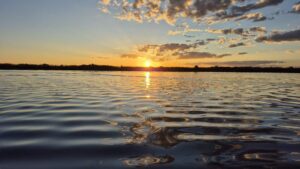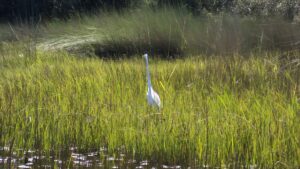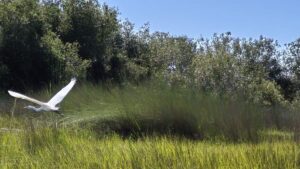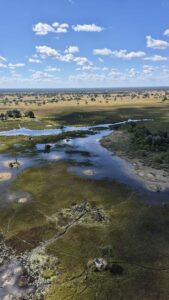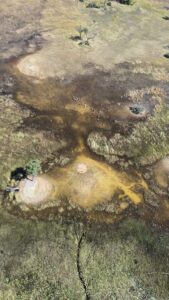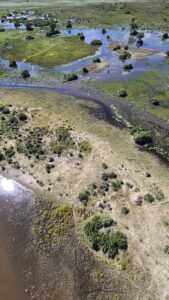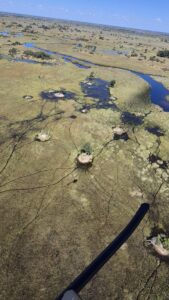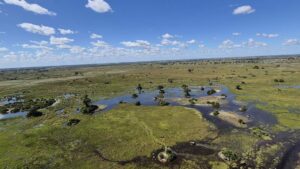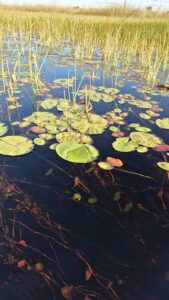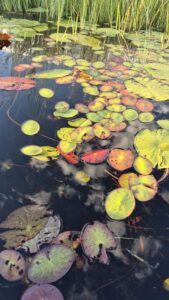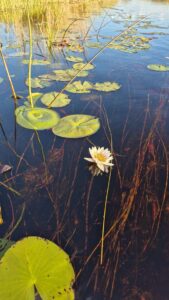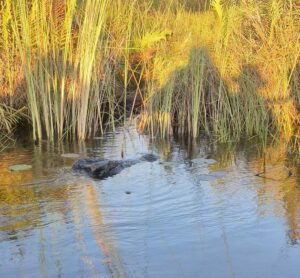
Our morning activity is a walk on Palm Island, but first we take a two boats to get there. We spot a semi submerged Crocodile lurking in the reeds – they are everywhere here, so no free swimming. King fishers and more Bee Eaters (who eat a variety of insects) and Herons are basking in the first rays of sunshine. On the Island ahead we can see the semi-aquatic Lechwes.
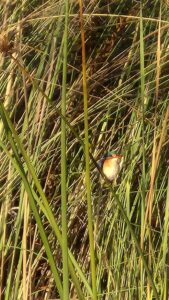
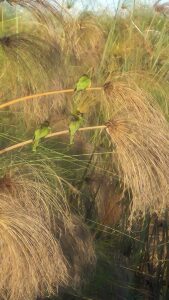
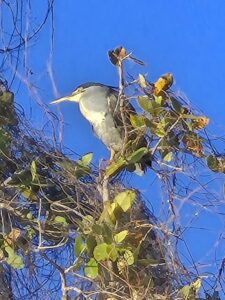
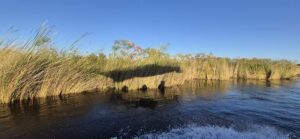
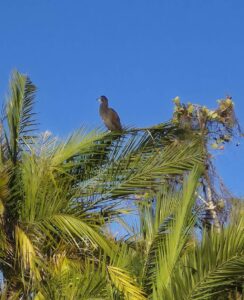
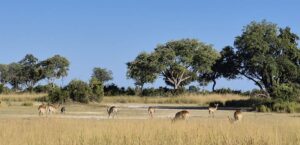
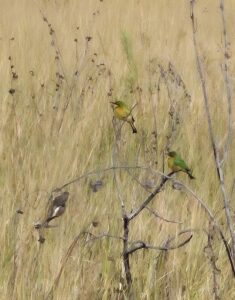
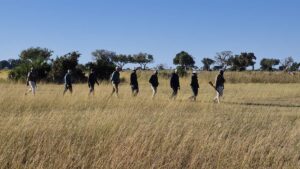 We are to travel in two groups each with two guides. The leading guide carries a loaded gun and the other brings up the rear with a First Aid Kit. We walk in strict single file all equi-distanced. I guess we look like a long animal – of sorts. Someone asks the lead guide if he will shoot to scare an attacking animal. ‘No’, is the answer, he cannot guarantee they will be scared. Safety is paramount and the group will travel only as fast as the slowest person.
We are to travel in two groups each with two guides. The leading guide carries a loaded gun and the other brings up the rear with a First Aid Kit. We walk in strict single file all equi-distanced. I guess we look like a long animal – of sorts. Someone asks the lead guide if he will shoot to scare an attacking animal. ‘No’, is the answer, he cannot guarantee they will be scared. Safety is paramount and the group will travel only as fast as the slowest person.
 There is a large herd of Buffalo in the distance many of them have white birds living symbiotically by feeding on the parasites on the hides of their hosts.
There is a large herd of Buffalo in the distance many of them have white birds living symbiotically by feeding on the parasites on the hides of their hosts.

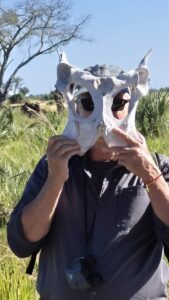
The Palm Trees are not indigenous. Elephants have brought them from distant parts of Africa during their migration. Given that their inefficient digestion takes twenty-four hours, this dispersal of seeds has taken thousands of years. We come across a Buffalo skull and pelvis bone – bleached white by the sun and long striped of flesh by scavengers.
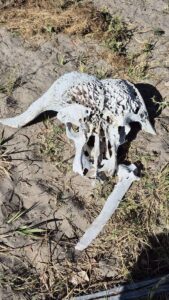
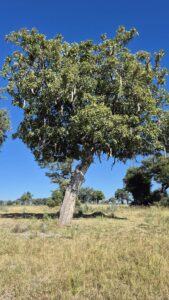
We get to meet the Sausage Tree – the heavy fruit are edible and the fibrous part can become a loofah.
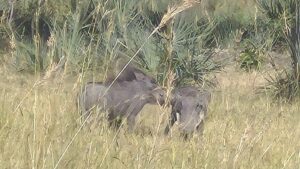
Wart Hogs abound and there is some courtship behaviour going on. The female is mounted by a young male but he doesn’t seem to know what to do. Suddenly a huge male with tusks comes running out of the undergrowth and dislodges the youngster. The older male doesn’t seem to be interested in stepping up with the female.
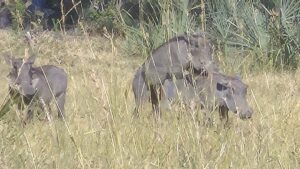
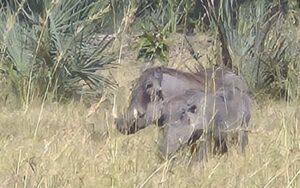
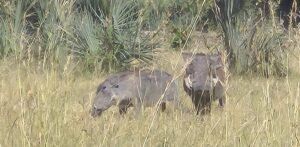
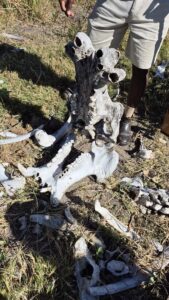
Our next skeleton is from a Hippo killed by lions jumping on it’s back where they are particularly vulnerable. The thick skin survives nearby with a hole in the back showing.
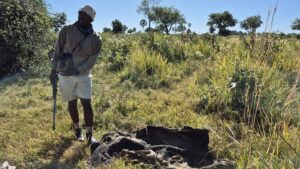
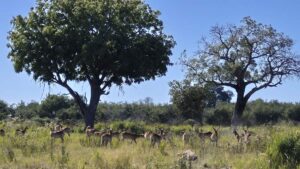
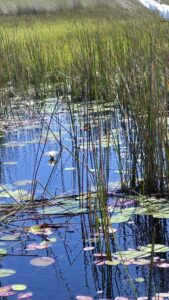 There are more Lechwes and Water Lilies when suddenly a White Herron is spotted – it takes flight with a dance like manoeuvrer of the wings.
There are more Lechwes and Water Lilies when suddenly a White Herron is spotted – it takes flight with a dance like manoeuvrer of the wings.
On the way back in the boat, we happen upon a huge crocodile on the bank with mouth open.
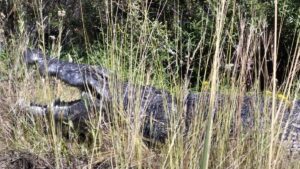
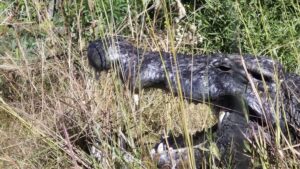
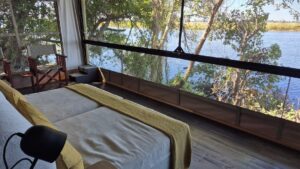
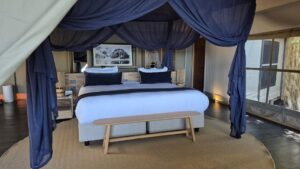
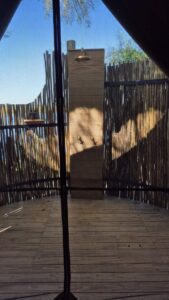
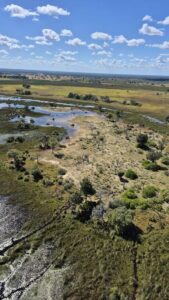 We have an added extra activity today – a helicopter ride in groups of two or three. We soar above the Delta area – it is a stunning view flying low enough to make out Elephants and Hippos. I’m on the first flight and the pilot spots a pair of Lions basking in the open grass. A few metres away is a low clump of bushes where their cubs are also sleeping. We can see the lines in the aquatic vegetation along which Hippos travel. The Pilot is Canadian. He asks me where our group comes from. I reply, ‘Three New Zealanders, one Australian and the rest are Americans who are all lovely, so please be kind to them.’
We have an added extra activity today – a helicopter ride in groups of two or three. We soar above the Delta area – it is a stunning view flying low enough to make out Elephants and Hippos. I’m on the first flight and the pilot spots a pair of Lions basking in the open grass. A few metres away is a low clump of bushes where their cubs are also sleeping. We can see the lines in the aquatic vegetation along which Hippos travel. The Pilot is Canadian. He asks me where our group comes from. I reply, ‘Three New Zealanders, one Australian and the rest are Americans who are all lovely, so please be kind to them.’
Helicopter Ride
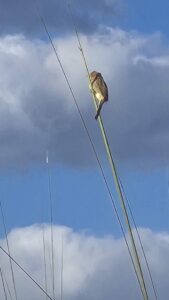
For my late afternoon activity, I choose the Mokoro. It’s the name for a traditional dug-out canoe, but these are made of dark brown fibreglass. Grey plastic seats without legs with a padded waterproof cover. Each Mokoro accommodates two plus a guide propelling us with a wooden pole. It’s a bit like a gondola, but instead of the architecture of Venice, we are looking as the patterns of Water Lilly leaves amongst the reeds.
There are many small insects to be seen close-up and ‘Striders’ use their long legs to skim over the surface.
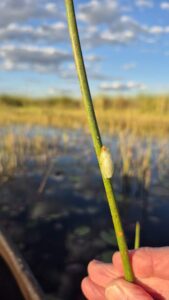
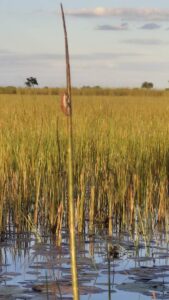
There are frogs here but it takes a while to spot them with their limbs folded up blending with a reed. They are almost impossible to photograph on a mobile phone due to auto-focus on the background. The Green Large Reed Frog is about 1.5 cm long and I also spot one with brown spots on it’s back blending in with a rust-spotted reed.

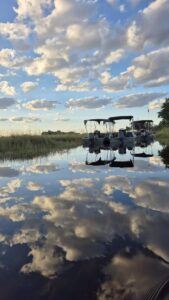
It’s a completely relaxing experience with a reward of fluffy white Barbie clouds reflected in the water. Sunset happens as we cross the lane back to the lodge.